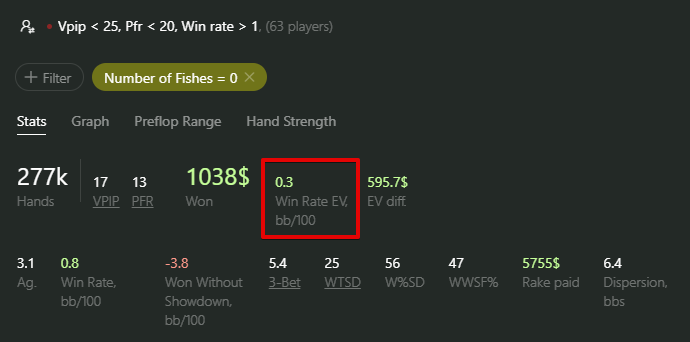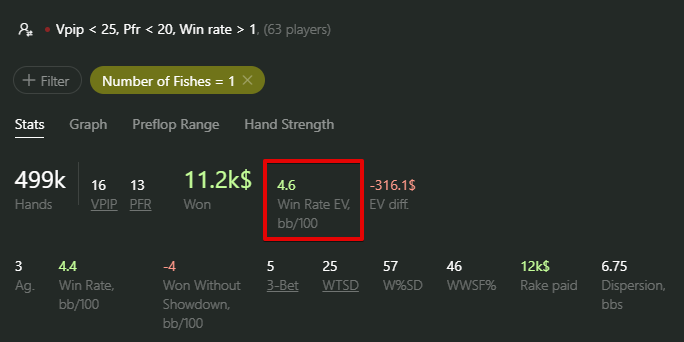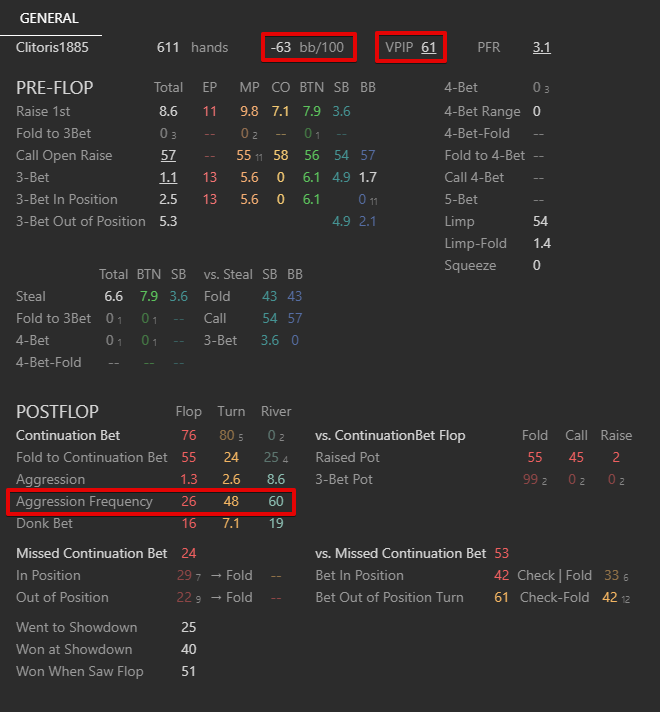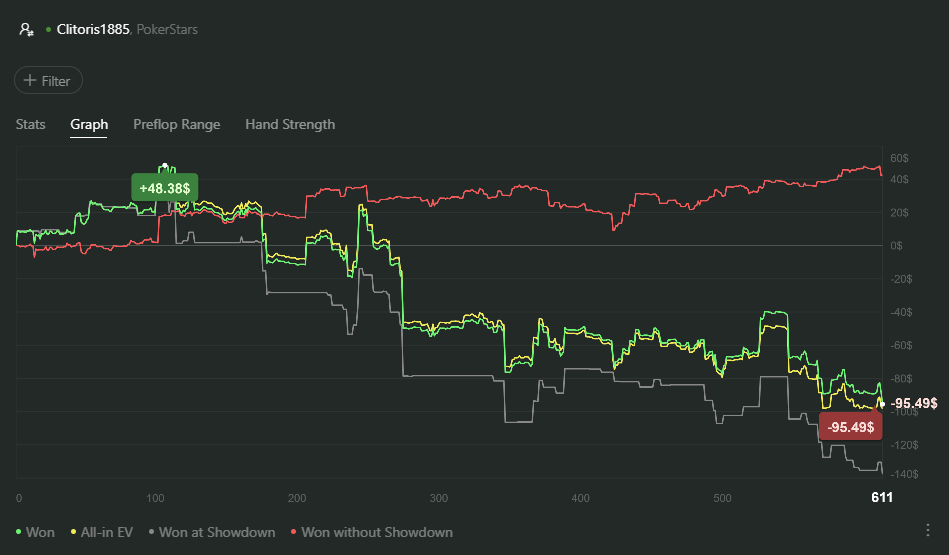5 vital aspects of table selection
Choosing the right tables to play at is a sure way to succeed in poker.
In this article, we’ll delve into 5 essential criteria that will guide you in selecting the most advantageous tables to maximize your win rate.
Table of Contents:
- Number of Fishes at the Table
# A Fish at the Table
The primary and arguably most crucial factor in table selection is having a fish at the table.
Playing against such opponents, you can increase your hourly earnings, winning more money in less time. Let’s confirm this using multi-player reports in Hand2Note 4:

For the report, I specifically chose winning regular players with a VPIP of no more than 25% and a PFR not exceeding 20%, ensuring their win rate was at least 1 bb/100. To maintain sample reliability, I set a condition that each of these players in my database had a minimum of 10,000 hands.
Subsequently, I filtered out all their hands where there wasn’t a single fish at the table.
In this article, we’ll be relying on the Win Rate EV bb/100 indicator, which provides a win rate based on expected value and eliminates the luck factor. According to the report, in such scenarios, the expected win rate of regular players was a mere 0.3 bb/100.
In Hand2Note 4, you can compare reports side by side. This is a useful feature that enables you to observe the correlation between the trend of interest and variations in specific parameters, and we’ll utilize it multiple times.
Let’s pin the obtained report, and in the new report on the right, utilize a filter to specifically select situations where there was at least one fish at the table. We’ll then compare the win rates of regular players in these two scenarios.

The data reveals that with the presence of a fish at the table, the win rate of regular players increased to 5.5 bb/100, a notably decent value.
If you aim to win more, choose tables with fish, rather than competing with regular players.
# Number of fishes at the table
More profitable than playing with one fish can only be playing with several fishes at the same table.
Remember those moments when you were dealt pocket aces, and all your opponents folded preflop? Unpleasant, isn’t it?
When there are 2 or 3 recreational players at the table simultaneously, the probability that at least one of them will participate in the hand, and you will win a big pot increases significantly. Let’s examine how the number of fishes at the table affects the win rate of regular players:

I used the same sample as in the previous example and set the parameter ‘Number of Fish’ to 1.
The report shows that the expected win rate of regular players at a table with one fish is 4.6 bb/100. Let’s track how it changes when there are 2 to 3 fishes at the table and compare the reports side by side:

The expected win rate increased to 7.7 bb/100, which is more than one and a half times higher.
The more fishes at the table, the more profitable it is to play. Keep an eye on tables with the highest number of recreational players and take a seat at them whenever the opportunity arises.
# VPIP of the Fish
The VPIP (Voluntarily Put money In Pot) statistic of a fish is one of the key indicators of how much money they are losing, and this stat should be prominently displayed in your main HUD.
The higher the VPIP of the fish, the wider the range of hands they play. As a result, postflop, they’re more likely to hold a weak hand, compelling them to either fold, go to showdown, or bluff. Such a perspective leads to significant losses.
Let’s monitor how the VPIP statistic value influences their loss rate:

I filtered out all the fishes with a VPIP between 50% and 60%, having at least 100 hands in my database. According to the report, such players exhibit a loss rate of -42 bb/100.
Now, let’s select the fishes playing with a VPIP of at least 70% and compare their loss rates:

In the report on the right, we can notice that the loss rate of fishes with a VPIP of 70% and higher is -73 bb/100. This implies that over the same period of time, they lose approximately one and a half times more money.
Opt for the tables with fishes who have a high VPIP to increase your winnings.
# Position on a fish
To maximize your winnings, it’s crucial not only to find a fish but also to secure the most advantageous seat relative to them.
The best position is to the left of the fish. It allows you to play a wide range of hands against the weaker player enjoying positional advantage, isolate them from other opponents with preflop raises, and dictate the flow of the hand postflop.
Let’s examine how my win rate will differ in scenarios when I occupied the least and most advantageous positions at the table relative to a fish playing with a VPIP of at least 50%.

In the left report, setting the parameter ‘Distance to Fish’ to 1, I selected situations where I occupied the least advantageous position relative to a fish - on their right. In such conditions, my expected win rate was 6.6 bb/100.
In the right report, I adjusted the ‘Distance to Fish’ parameter to -1, filtering scenarios where I held the optimal position directly to the left of a fish. Not surprisingly, under such favorable circumstances, my expected win rate increased to 15 bb/100, more than doubling the previous rate.
Never underestimate the importance of a positional factor. It’s essential to consistently choose the best position on a fish.
# Fish’s Tendencies
Once you find yourself at a table with a fish, swiftly analyze their playing tendencies to understand how you can extract maximum profit when involved in a hand with them.
The opponent’s playing style and their weaknesses can be identified from their popup and graph in Hand2Note 4.
Let’s consider an example:

In the popup, we can see that the player is a fish with a VPIP of 61% and a loss rate of -63 bb/100.
Notably, postflop their aggression frequency increases with each street, reaching 60% on the river. An indicator this high suggests that the fish adopts a very aggressive playing style. Let’s examine their graph:

The graph also confirms the aggressive tendencies of the fish. The rise of the red line, which represents winnings without showdown, indicates that this player wins many small and medium-sized pots when their bluff succeeds.
At the same time, there is a decline in the gray line, which corresponds to winnings at showdown. This happens because the fish loses many big pots in situations where their bluff is caught.
If you are interested in how to exploit aggressive fishes, we recommend reading our article “5 Exploitative Adjustments Against Aggressive Fish”.
Selecting the right table is an essential skill for any professional poker player. By using Hand2Note 4, you can easily identify fishes at the table, analyze their tendencies, and exploit weaknesses in their game.
# 5 vital aspects of table selection
Choosing the right tables to play at is a sure way to succeed in poker.
In this article, we’ll delve into 5 essential criteria that will guide you in selecting the most advantageous tables to maximize your win rate.
Table of Contents:
- Number of Fishes at the Table
# A Fish at the Table
The primary and arguably most crucial factor in table selection is having a fish at the table.
Playing against such opponents, you can increase your hourly earnings, winning more money in less time. Let’s confirm this using multi-player reports in Hand2Note 4:

For the report, I specifically chose winning regular players with a VPIP of no more than 25% and a PFR not exceeding 20%, ensuring their win rate was at least 1 bb/100. To maintain sample reliability, I set a condition that each of these players in my database had a minimum of 10,000 hands.
Subsequently, I filtered out all their hands where there wasn’t a single fish at the table.
In this article, we’ll be relying on the Win Rate EV bb/100 indicator, which provides a win rate based on expected value and eliminates the luck factor. According to the report, in such scenarios, the expected win rate of regular players was a mere 0.3 bb/100.
In Hand2Note 4, you can compare reports side by side. This is a useful feature that enables you to observe the correlation between the trend of interest and variations in specific parameters, and we’ll utilize it multiple times.
Let’s pin the obtained report, and in the new report on the right, utilize a filter to specifically select situations where there was at least one fish at the table. We’ll then compare the win rates of regular players in these two scenarios.

The data reveals that with the presence of a fish at the table, the win rate of regular players increased to 5.5 bb/100, a notably decent value.
If you aim to win more, choose tables with fish, rather than competing with regular players.
# Number of fishes at the table
More profitable than playing with one fish can only be playing with several fishes at the same table.
Remember those moments when you were dealt pocket aces, and all your opponents folded preflop? Unpleasant, isn’t it?
When there are 2 or 3 recreational players at the table simultaneously, the probability that at least one of them will participate in the hand, and you will win a big pot increases significantly. Let’s examine how the number of fishes at the table affects the win rate of regular players:

I used the same sample as in the previous example and set the parameter ‘Number of Fish’ to 1.
The report shows that the expected win rate of regular players at a table with one fish is 4.6 bb/100. Let’s track how it changes when there are 2 to 3 fishes at the table and compare the reports side by side:

The expected win rate increased to 7.7 bb/100, which is more than one and a half times higher.
The more fishes at the table, the more profitable it is to play. Keep an eye on tables with the highest number of recreational players and take a seat at them whenever the opportunity arises.
# VPIP of the Fish
The VPIP (Voluntarily Put money In Pot) statistic of a fish is one of the key indicators of how much money they are losing, and this stat should be prominently displayed in your main HUD.
The higher the VPIP of the fish, the wider the range of hands they play. As a result, postflop, they’re more likely to hold a weak hand, compelling them to either fold, go to showdown, or bluff. Such a perspective leads to significant losses.
Let’s monitor how the VPIP statistic value influences their loss rate:

I filtered out all the fishes with a VPIP between 50% and 60%, having at least 100 hands in my database. According to the report, such players exhibit a loss rate of -42 bb/100.
Now, let’s select the fishes playing with a VPIP of at least 70% and compare their loss rates:

In the report on the right, we can notice that the loss rate of fishes with a VPIP of 70% and higher is -73 bb/100. This implies that over the same period of time, they lose approximately one and a half times more money.
Opt for the tables with fishes who have a high VPIP to increase your winnings.
# Position on a fish
To maximize your winnings, it’s crucial not only to find a fish but also to secure the most advantageous seat relative to them.
The best position is to the left of the fish. It allows you to play a wide range of hands against the weaker player enjoying positional advantage, isolate them from other opponents with preflop raises, and dictate the flow of the hand postflop.
Let’s examine how my win rate will differ in scenarios when I occupied the least and most advantageous positions at the table relative to a fish playing with a VPIP of at least 50%.

In the left report, setting the parameter ‘Distance to Fish’ to 1, I selected situations where I occupied the least advantageous position relative to a fish - on their right. In such conditions, my expected win rate was 6.6 bb/100.
In the right report, I adjusted the ‘Distance to Fish’ parameter to -1, filtering scenarios where I held the optimal position directly to the left of a fish. Not surprisingly, under such favorable circumstances, my expected win rate increased to 15 bb/100, more than doubling the previous rate.
Never underestimate the importance of a positional factor. It’s essential to consistently choose the best position on a fish.
# Fish’s Tendencies
Once you find yourself at a table with a fish, swiftly analyze their playing tendencies to understand how you can extract maximum profit when involved in a hand with them.
The opponent’s playing style and their weaknesses can be identified from their popup and graph in Hand2Note 4.
Let’s consider an example:

In the popup, we can see that the player is a fish with a VPIP of 61% and a loss rate of -63 bb/100.
Notably, postflop their aggression frequency increases with each street, reaching 60% on the river. An indicator this high suggests that the fish adopts a very aggressive playing style. Let’s examine their graph:

The graph also confirms the aggressive tendencies of the fish. The rise of the red line, which represents winnings without showdown, indicates that this player wins many small and medium-sized pots when their bluff succeeds.
At the same time, there is a decline in the gray line, which corresponds to winnings at showdown. This happens because the fish loses many big pots in situations where their bluff is caught.
If you are interested in how to exploit aggressive fishes, we recommend reading our article “5 Exploitative Adjustments Against Aggressive Fish”.
Selecting the right table is an essential skill for any professional poker player. By using Hand2Note 4, you can easily identify fishes at the table, analyze their tendencies, and exploit weaknesses in their game.















